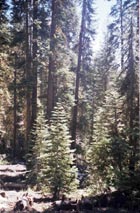Microbial Processes > Long-Term Soil Productivity (LTSP) Study > Forest Locations > California Region
California's forests are extremely productive. Although accounting for only 3 percent of the Nation's commercially forested land, this state has played a major role in meeting our Nation's needs for forest products. In terms of productive capacity, only Oregon and Washington rank higher.
 In California, LTSP research centers on the mixed conifer forest. This forest type occupies 9.3 million acres (40 percent of our forested land). The first experimental site (the Nation's second) was established in 1991 at the Challenge Experimental Forest, operated by the Forest Service's Pacific Southwest Research Station. Since then, other sites have been established. And by 1995, a dozen installations were operating across the western slopes of the Sierra Nevada and Cascade Range.
In California, LTSP research centers on the mixed conifer forest. This forest type occupies 9.3 million acres (40 percent of our forested land). The first experimental site (the Nation's second) was established in 1991 at the Challenge Experimental Forest, operated by the Forest Service's Pacific Southwest Research Station. Since then, other sites have been established. And by 1995, a dozen installations were operating across the western slopes of the Sierra Nevada and Cascade Range.
Besides a standard set of measurements to be recorded at all installations, the California sites are providing valuable insights into rates of soil erosion, soil faunal activity, and organic matter recycling in response to site disturbance. The effectiveness of both conventional and innovative recovery treatments are also being tested.
Intermountain Region and So. Oregon Cascades >

